The Best Clear Coat for Painted Wood, 2025 (Tested & Reviewed)
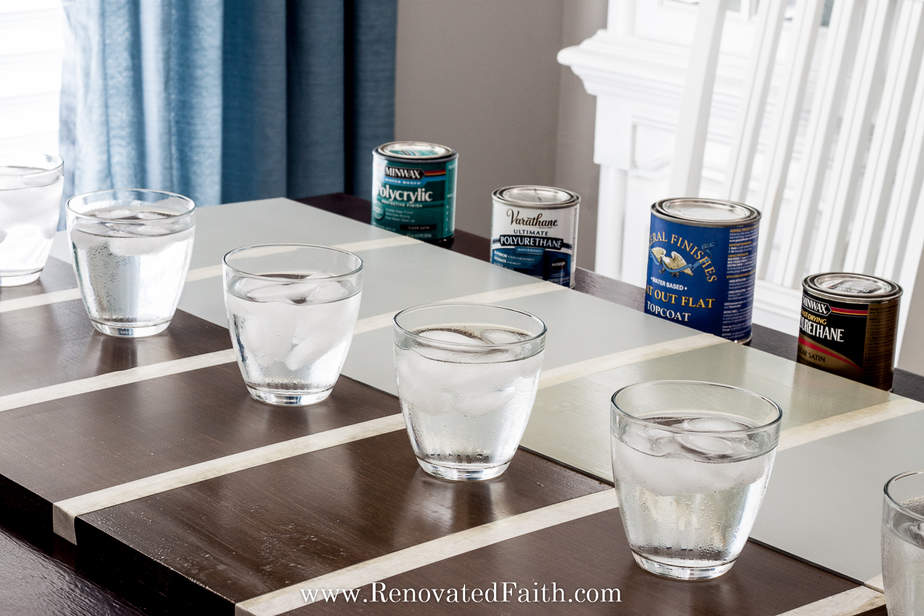
The Best Paint Sealers for Wood (Side-by-Side Comparison)
After blind-testing 8 top products, I’ve found the best clear coat for furniture (and the best chalk paint sealer) – and it’s not wax!
Don’t allow your project to be ruined by using the wrong sealer! Instead, protect it by applying the absolute best clear coat for painted wood furniture!
I’ve tested 8 of the most popular topcoats and compared reviews to find the best protective finish for your next furniture project and also the easiest chalk paint sealer and wax alternative!
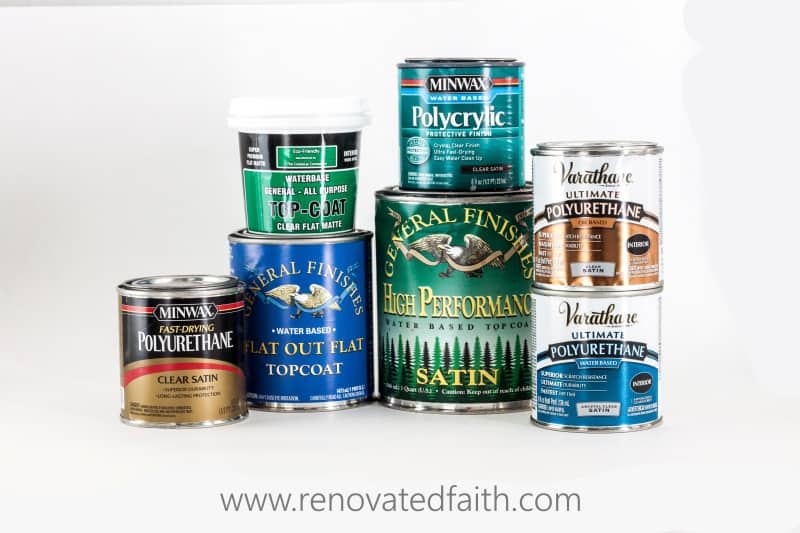
As someone who has painted dozens of different furniture pieces, I’ve learned that not all topcoats are created equal and that different surfaces need different protective finishes.
In this post, I’ll help you find the right sealer for your DIY project that not only provides a protective finish but also makes your furniture piece look amazing!
LET ME SHOW YOU:
- What I did to test and review several sealers to find the best clear coat for painted wood
- The overall best topcoat for various wood finishes including chalk-painted furniture
- My best tips and a step-by-step guide on how to apply a clear coat to painted or stained wood
- How to seal chalk paint without the hassle of wax but with the same farmhouse finish
- The absolute best clear paint sealer for wood and why wax is not the best top coat for chalk paint
What is the Best Sealer for Wood Projects?
Have you ever spent hours refinishing a piece of furniture only to have the top ruined by a drinking glass ring or even a scratch?
And even worse, have you added a protective finish to painted wood that left streaks or haziness on your beautiful finish?
If you have, you know how incredibly frustrating that can be. I get it! Depending on the finish, sometimes the only solution is to completely refinish the whole surface. Fortunately, if you apply a clear coat, your flawless finish will be preserved and protected for years to come!
Would you own a home without insuring it? In the same way, a topcoat (or clear coat) acts as an insurance policy against the potential damage caused by the daily use of everyday life.
Especially if you have young kids, your tabletop, desk, or other small projects can be easily ruined with an accidental scratch or water damage from a drinking glass left on it for too long – not to mention spills!
I don’t know about you but when it comes to furniture pieces that get a lot of use, I want them to be protected against the potential damage and unexpected spills of everyday life.
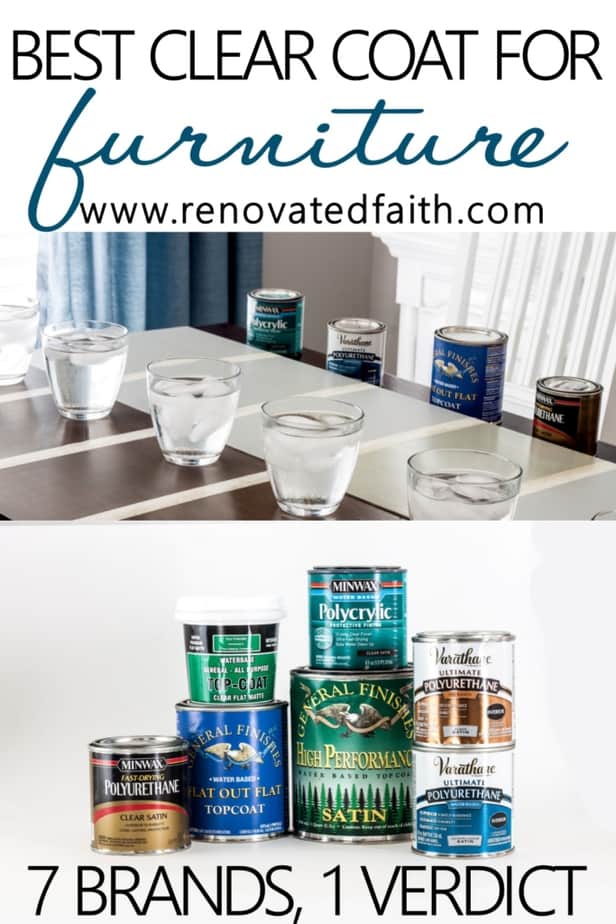
(As an Amazon affiliate I earn from qualifying purchases. I only use affiliate links on products I use and love. Please see my full disclosure HERE).
Quick Links to Information in this Post
- 1 The Best Paint Sealers for Wood (Side-by-Side Comparison)
- 2 What is the Best Sealer for Wood Projects?
- 3 The Best Sealer for Wood Furniture
- 4 What is a clear coat?
- 5 Choosing the Right Clear Coat for Painted Wood
- 6 DOES Chalk Paint Need to Be Sealed?
- 7 What Happens if You Don’t Wax Chalk Paint?
- 8 Can You Use a Clear Coat on Chalk Paint?
- 9 How to Seal Chalk Paint EASILY
- 10 Two Types of Clear Coats for Furniture
- 11 Benefits of Using a Clear Coat on Furniture
- 12 Our Candidates for the Best Clear Coat for Painted Wood Furniture (in no particular order)
- 13
- 14 The Best Top Coat for Painted Furniture: How We Chose Our Best Picks
- 15 The All-Around Best Clear Coat For Painted Wood Furniture: Varathane Water-Based Polyurethane, Satin
- 16 Best Top Coat for Chalk Paint – General Finishes High-Performance Top Coat in Flat (UPDATE: And Varathane Water-Based Poly)
- 17 The Easiest Chalk Paint Sealer to Apply
- 18 The Best Chalk Paint Protective Top Coat: Why I Love It:
- 19 Best Sealer for Chalk Paint: 2025 UPDATE
- 20 Best Clear Coat for White Paint: CrystaLac Super Premium Clear Top Coat
- 21 Most Water-Resistant Clear Coat
- 22 Overall Best Paint Sealer for Wood
- 23 Best Sealer for Wood (Raw or Stained)
- 24 The Best Green Wood Sealer
- 25 The Best Sealer for Outdoor Furniture
- 26 How To Seal Chalk Paint or Latex Paint Easily
- 27 Best Protective Finish for Stained Wood
- 28 How The Other Contenders Performed:
- 29 What Sheen Should I Use on Furniture?
- 30 FAQ’s – Best Clear Coat For Painted Wood:
- 31 Posts Related to the Best Top Coat for Paint:
- 32 Applying the Right Top Coat to Wood Furniture: Final Thoughts
- 33 Reviews for the Best Clear Coat for Wood (Best Sealer for Chalk Paint)
The Best Sealer for Wood Furniture
☑️ After blind-testing several leading top coats, here is the best clear coat for painted wood furniture (CLICK HERE FOR THE CURRENT PRICE)
What is a clear coat?
A clear coat (often referred to as a poly finish or topcoat) is basically a clear protective layer that you brush on your painted or stained furniture piece after it has dried. This clear acrylic layer gives the piece a shield against scratches, water rings from drinking glasses, and just dirt in general.
Choosing the Right Clear Coat for Painted Wood
The protective coating makes cleaning furniture pieces easier because dirt can’t penetrate the paint surface. Instead, it wipes cleanly and easily from the topcoat!
There are so many options when it comes to clear coats. Not only can you pick from any sheen (flat, satin, semi-gloss, and glossy finish) but there are oil-based clear coats and water-based.
Some wood sealants might be harder but can also leave a yellow haze on white pieces. Also, some can tend to leave hazy streaks which can be obvious on dark furniture pieces.
That’s why selecting the right clear coat for your painted wood furniture is so important. The best top coat is the one that you can’t tell is there.
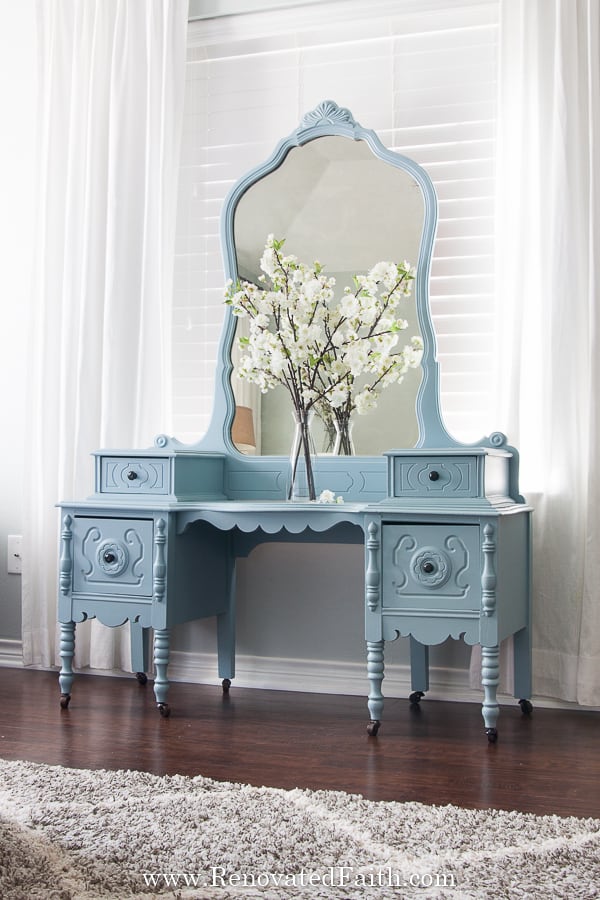
Related: The Ultimate Guide to Refinishing Furniture (The ONLY Tutorial You’ll Ever Need!)
What furniture pieces need a clear coat?
Why should I protect my painted furniture with a topcoat? Any hard furniture that gets a decent amount of regular use needs protection.
I recommend using a clear coat on “high-traffic” furniture pieces like dining tables, coffee tables, desks, end tables, or entry tables as these are all used daily and subject to wear and tear.
Dark paint colors are especially susceptible to showing smudges and dust so I use a clear coat on those to provide protection. Also, it’s a good idea to use a top coat on any furniture pieces exposed to regular humidity like kitchen or bathroom cabinets.
Whether you are looking for the best top coat for chalk paint or even for latex paint or stain, this is a good general rule of thumb:
BOTTOM LINE: If your painted wooden furniture piece will come into regular contact with water, food, or little fingerprints, you need a topcoat for the ultimate protection! Not all top coats are created equally but after blind-tested 8 products, I’ll share with you the best waterproof sealer for painted wood.
Do You Need a Clear Coat For Painted Wood?
This even goes for latex-painted furniture pieces. Although regular paint is very durable, it still benefits from an extra coating of protection.
The top coat makes the surface harder and therefore more durable. Also, clear coats are much more waterproof than latex as latex paints can bubble up if a little water penetrates the paint or wood surface.
Related: The Best Paint for Furniture (24 Brands Blind-Tested & Reviewed) | The 33 Most Popular Paint Colors for Kitchen Cabinets
To save you time, you can always just clear coat the top portion of your table as the tabletop gets considerably more wear and tear. However, if you use chalky paint, it will need a sealer over the entire surface of the piece.
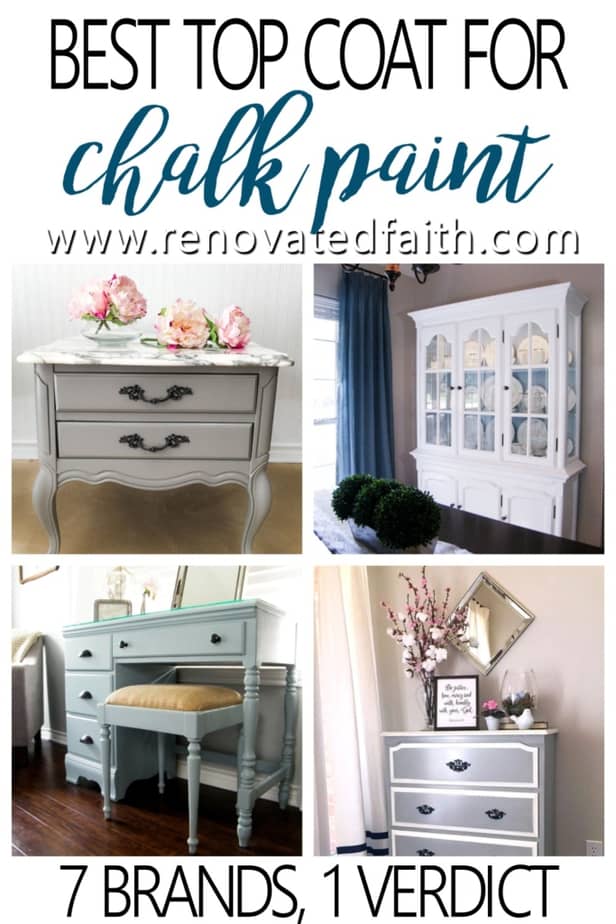
DOES Chalk Paint Need to Be Sealed?
Chalk paint does a decent job of sticking to surfaces. That chalky, matte texture has more gripping ability than a few other paints. (See how chalk paint did in my testing: The Best Paint for Furniture (24 Brands Blind-Tested and Reviewed)
But, the same properties that help paint adhere to things make them horrible at protecting the wood’s surface. Chalk paint is not known for its durability and it is not waterproof, so it needs some kind of coating to provide a harder surface and to seal in the paint.
What Happens if You Don’t Wax Chalk Paint?
Unlike latex-painted or stained projects, chalk-painted furniture needs a protective finish unless you know a drinking glass will never be set on it. If a chalk-painted piece without wax or a top coat comes into contact with water, the paint can actually re-liquefy!
So if a cold drink is placed on unsealed chalk paint, you could be left with a puddle of paint on your now-ruined furniture piece not to mention the potential of wet paint on your rug or clothing.
What Do You Seal Chalk Paint With?
Clear wax is not the only option for sealing chalk-painted pieces of furniture. Furniture wax can be a beast. Not only is there a learning curve but it is time-consuming to apply the wax. Then, it can be hard to get a consistent finish, not to mention the wax and the brush are expensive.
Also, it does not make the painted surface harder (because it’s wax) and it has to be reapplied every 6 months. – I wish I was joking but to maintain that wax finish you have to reapply the wax every so often.
Can You Use a Clear Coat on Chalk Paint?
The good news is that there are some great alternatives to wax on chalk-painted furniture. I’ve used the same product I recommend below on dozens of pieces and have had excellent results.
And to save you some time, my favorite clear coat for any kind of paint is Varathane Water-based Polyurethane (See reviews here.) It also comes in a satin and matte finish so you get the same sheen as furniture wax.
What About A Top Coat for Chalk Painted Pieces That Are Seldom Used?
All chalk-painted pieces need some kind of sealant. The chalk paint itself isn’t durable enough and you will need that protection to ensure your furniture piece continues to look good.
How to Seal Chalk Paint EASILY
“How do you seal chalk paint without having to use wax?” I get that question a lot. Perhaps you are familiar with using wax as a protective coating on chalk paint but did you know you can more easily apply a top coat and your surface will be better protected from water?
While sealing wax can waterproof a surface, there is a definite learning curve with applying wax properly. If not enough wax is not properly buffed onto the surface, it can be easily penetrated with water and the surface will be ruined if a cold drink is left on the surface.
Also, wax has to be reapplied every 6 months to a year to be effective! Later, we’ll discuss the best chalk paint top coat as opposed to waxing!
By applying a clear coat to unsealed chalk paint, you can get a more durable, waterproof finish, but without the time, effort, and extra expense of wax!
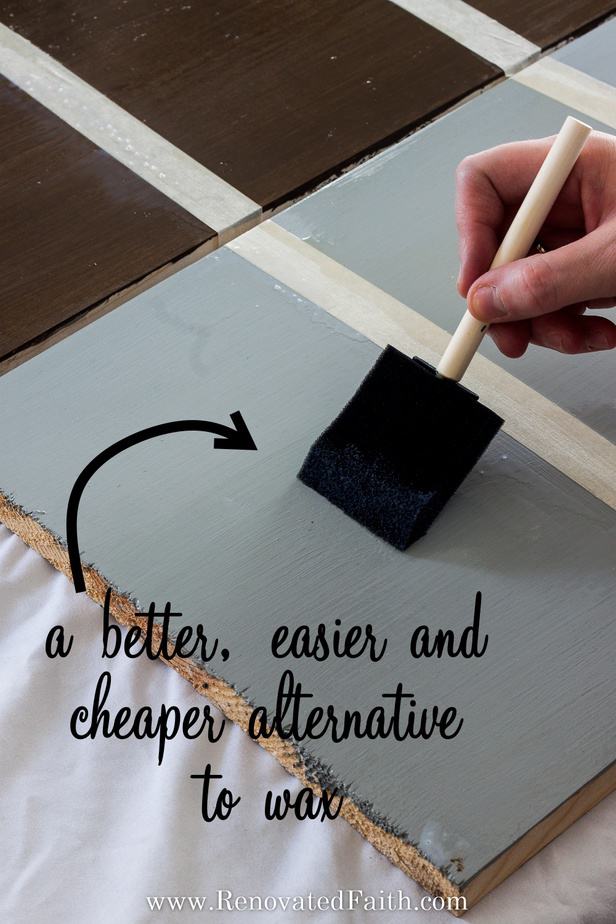
Two Types of Clear Coats for Furniture
There are two basic types of topcoats for furniture: water-based and oil-based. Traditionally, oil-based polyurethanes were the main clear coats used on furniture but now more water-based formulas are on the market. Here’s a little about the pros and cons of each:
1. Water-Based Clear Coats
It used to be that all clear polyurethanes were oil-based but now you are seeing several polyurethanes that are water-based and just as durable! Minwax polycrylic sealer is a popular choice as a water-based version of polyurethane and one of the topcoats we tested.
Water-based clear coats are easy to clean up, have low odor and the finish is much less likely to change over time.
Water-based top coats also dry quickly and can be used on a bare, stained, or painted wood surface.
Clean-up is easy with water-based clear coats as you can rinse your paintbrush with warm water.
2. Oil-Based Clear Coats
Oil-based polyurethanes were always the more durable choice but now they have a lot of competition as water-based formulas have improved. Oil-based products have a strong odor and can take longer to dry. However, the longer drying time can mean fewer brush strokes.
Oil-based topcoats can have an ambering effect, which means that over time the clear coat can cause the surface of the furniture piece to yellow. If you have a dark-stained piece of furniture, this won’t be detectable and can even warm up the color of the wood slightly over time. But if you have a white-painted furniture piece, you can see how yellowing would be problematic!
Also, oil-based clear coats require cleaning your brushes with mineral spirits.
Oil-based polys are very water-resistant but are not recommended for outdoor use as they may crack or yellow when exposed to UV light.
Fortunately, I have found a great water-based exterior sealant and go into detail at the end of the post.
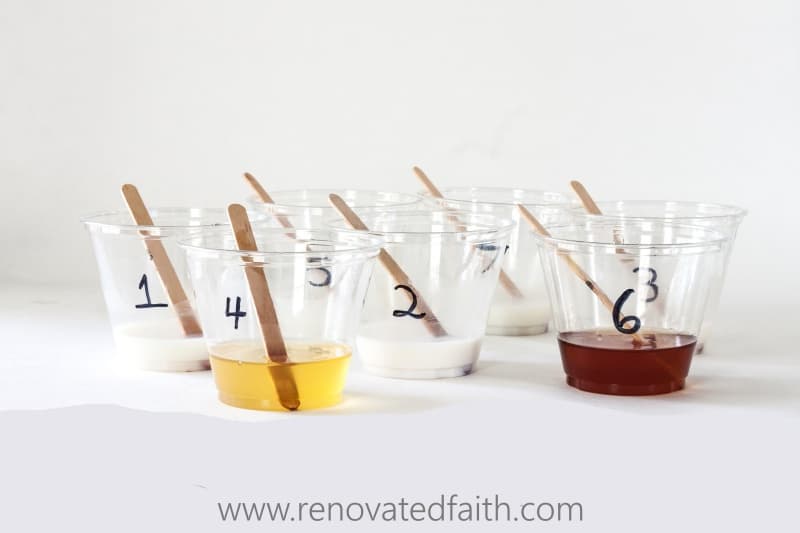
Benefits of Using a Clear Coat on Furniture
Any furniture piece can benefit from a protective finish but especially those that get a lot of use daily will be better safeguarded from damage, fingerprints, water stains, and smudges. A good sealant is an insurance policy to keep a furniture piece in good condition.
Often, the oils from your hands can react with the not-so-smooth surface of chalk paint or matte latex. Over time, those fingerprints and smudges will make your piece look dingy – and not in a rustic farmhouse way.
Those dreaded water rings from drinking glasses can easily ruin a furniture piece but with the right amount of clear coat, you can leave glasses on your coffee table overnight with no damage to the surface!
Applying a good chalk paint clear coat is a great way to make horizontal surfaces so much easier to wipe. I can’t imagine having a tabletop without a clear coat for easy clean-up afterward.
Many faux finishes use glaze and special techniques to highlight different features of the furniture. Sometimes those glazes are not waterproof so you can easily seal in those details for good with a top coat!
Also, a clear coat will save you time on touching up furniture pieces later. It will also allow you to scrub furniture without ruining the paint finish.
Our Candidates for the Best Clear Coat for Painted Wood Furniture (in no particular order)
- Minwax Water-Based Polycrylic Protective Finish
- Varathane Water-Based Polyurethane
- General Finishes Flat Out Flat Topcoat
- Minwax Fast-Drying Polyurethane
- Crystalac Water-based General All-Purpose Top Coat
- Varathane Ultimate Polyurethane, Oil-Based
- General Finishes High-Performance Top Coat
- Annie Sloan Wax
There are other great topcoat options like tung oil and linseed oil. These are natural top coat alternatives to poly topcoats but I wanted to test products that are not only protective against damage but water infiltration. Clear liquid oils made from natural chemicals aren’t as effective as other clear sealers but there are still several winners on the list with low VOCs.
The Best Top Coat for Painted Furniture: How We Chose Our Best Picks
We did a blind test on 8 of the most popular choices of clear coats for furniture. I found these by going to 4 different Facebook furniture groups I am part of.
Each group consists of hundreds of professional furniture painters. After finding out their favorite clear coats, I narrowed down their favorites to the top 8.
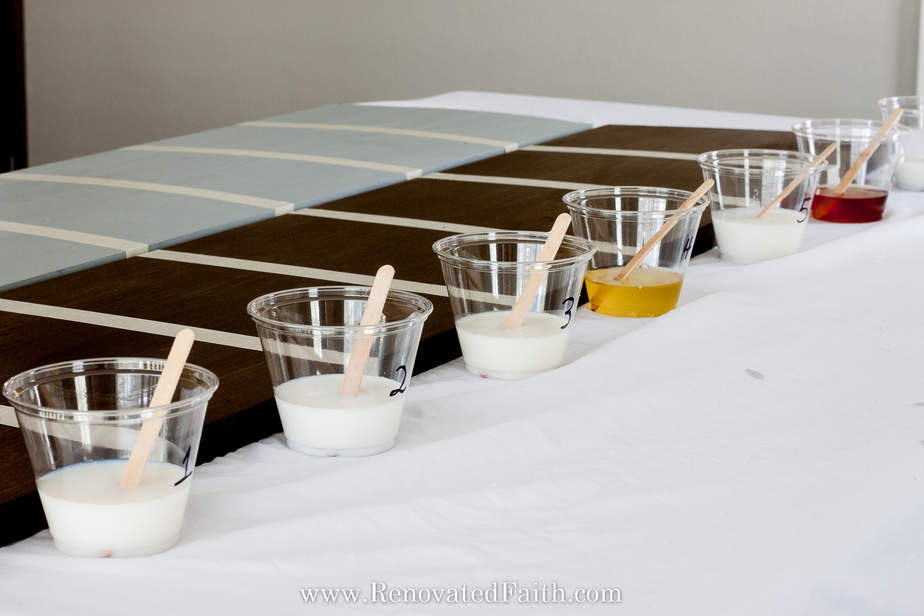
Testing to Find the Best Clear Coat for Wood
Using painter’s tape, I made seven different sections on each of the two pieces of wood. One was painted and one was stained. On each section, I put a total of three layers of topcoat with very light sanding in between. I used an inexpensive foam brush to apply the protective finish. (You can also use a foam roller.)
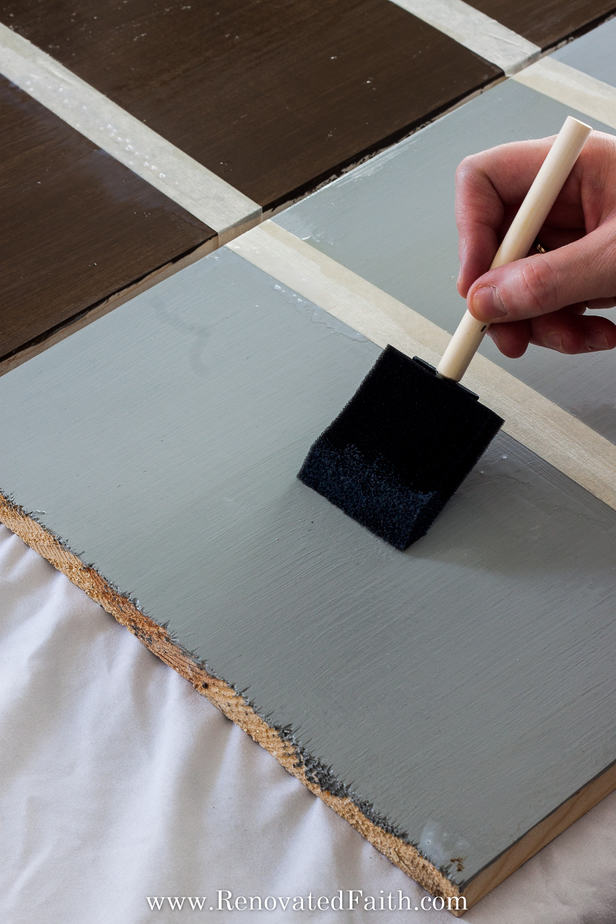
The Cold Drink Test
After letting the last coat dry, I let the two wood planks cure for two weeks to reach maximum hardness and water impermeability for each sample. Then, I put glasses of ice water on each sample for 24 hours to see which samples allowed a ring to appear.

Criteria for the Best Top Coat For Furniture Projects:
- Ease of Application
- Surface Smoothness
- Expense
- Durability
- Water Permeability
- Sheen
- Clarity
- No or Low VOC’s
The All-Around Best Clear Coat For Painted Wood Furniture: Varathane Water-Based Polyurethane, Satin
After testing seven different products, Varathane’s Water-Based Polyurethane was the clear winner! This clear coat is great for interior products including furniture, cabinets, trim, or any other pieces of wood.
Varathane states it has the best scratch and stain resistance available and based on our findings, I believe them! It has a low odor, with easy soap and water clean-up. It also dries quickly once applied. You can click here to see more reviews and the current price: Where to Buy Varathane Water-based Polyurethane
2 YEAR UPDATE:
After a couple of years of using Varathane’s Waterbased Polyurethane on several furniture projects including my dining room table, coffee table, and breakfast table, I’ve been really impressed with the long-term results.
On each project, I put at least 4 coats of clear sealer and I’ve been so happy with how well they have held up to condensation from drinks and everyday use.
The best part is how smoothly this product goes on any surface. I’ve never had any trouble with haziness or streaks – the surface is always completely transparent no matter how many additional coats.
IMPORTANT NOTE: With certain colors, this clear coat will have a blue or purple tint when you first put it on. It actually made my coffee table top an eggplant color. But No Worries! This is temporary and it will dry to a clear finish in a few minutes.
What Reviewers Have to Say:
Many reviewers have used it in a paint sprayer with no problem and have even used it without sanding between coats. Just be sure to not shake the can (only stir) to reduce air bubbles.
One reviewer found that when they brushed it on there were several bubbles in the finish but those bubbles popped during the drying time to leave a smooth coat with no brush marks! Click here for more reviews.
Why I Love It:
Varathane’s Water-based Polyurethane is a fabulous product that was easy to apply. Some bubbles were left in the finish but they quickly popped upon drying leaving a super smooth finish with no brush marks.
After three coats, the finish was still very clear and not hazy at all, even on the stained sample. The satin varnish is very nice and not too glossy! Also, this formula was the best-performing water-based clear coat when it came to water rings as no ring was left after 24 hours.
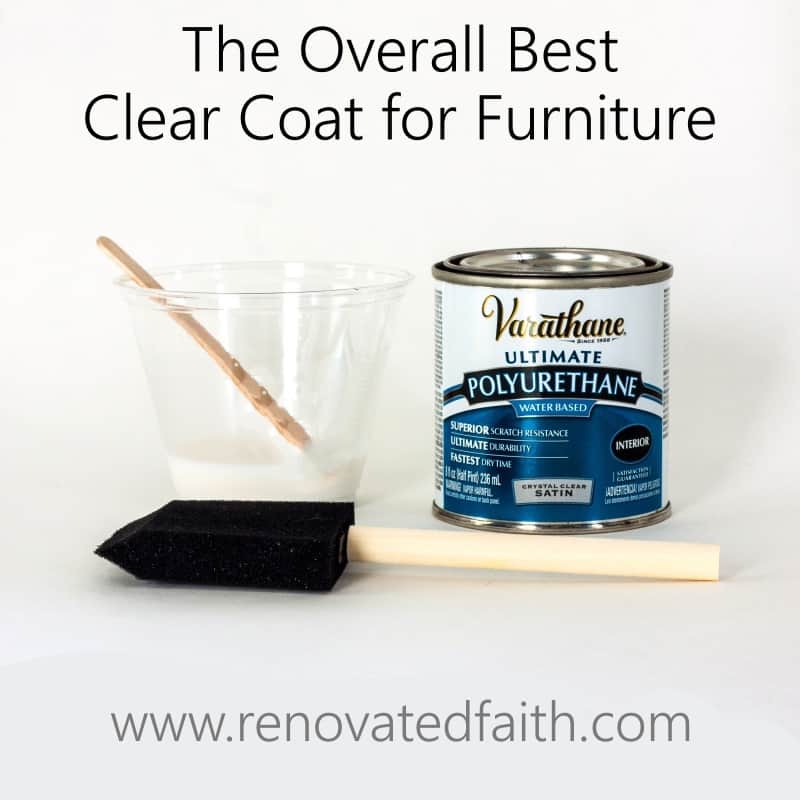
CLICK HERE TO SEE THE CURRENT PRICE FOR THE BEST CLEAR COAT FOR PAINTED WOOD FURNITURE
Best Finish for a Dining Table Top:
This topcoat was also the best clear coat for tabletops because it’s resistant to scratches, stains, and water. One common concern for a kitchen table is the clear coat’s ability to protect against condensation from glasses and this top coat performed best!
Best Budget-Friendly Top Coat:
To my surprise, Varathane’s Water-Based Top Coat was also the best affordable option for furniture. Crystalac’s Water-based topcoat was a close second but the price is almost twice as much.
You can see how I used Varathane’s Water-Based Polyurethane on the coffee table we built over the faux wood stain: DIY Farmhouse Coffee Table with Turned Legs
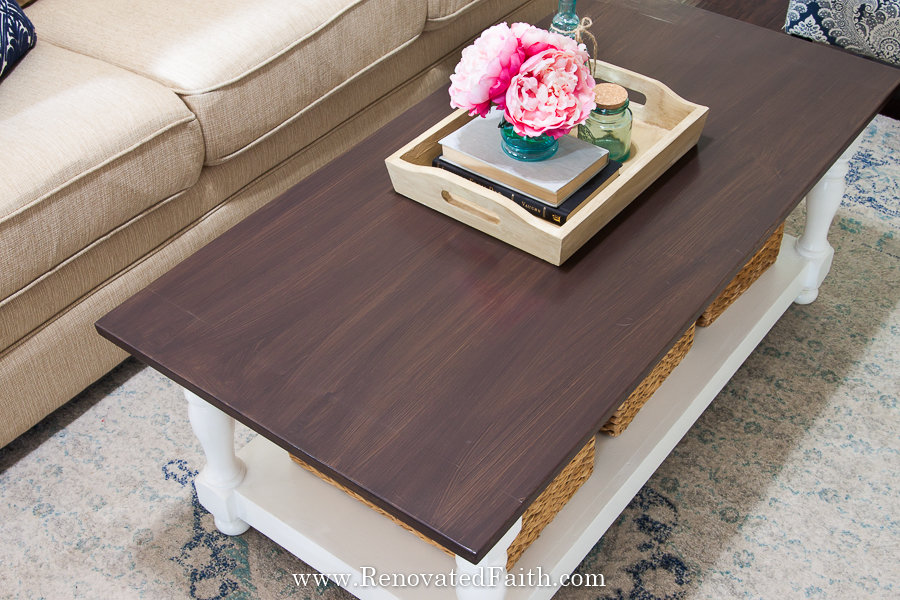
Best Top Coat for Chalk Paint – General Finishes High-Performance Top Coat in Flat (UPDATE: And Varathane Water-Based Poly)
The best sealer for chalk paint is General Finishes Top Coat which does an outstanding job of preserving the look, feel, and color of chalk paint. Their Flat High-Performance Top Coat is a clear, flat, water-based topcoat and excels at making chalk-painted or milk-painted projects much more durable. 2
023 UPDATE: At the time I wrote this post, Varathane Waterbased Polyurethane did not have a flat (matte finish) but now they do. Because it is a cheaper option, it would probably be my personal preference, but GF Flat High Performance Finish was just as effective.
These two clear coats were the only ones that didn’t leave any evidence of drink rings, even after the drinks were left on sealed wood overnight.
Does chalk paint need a topcoat?
The very ingredient that gives chalk and milk paints their velvety look and powdery feel works against them in the durability department. This is especially the case with chalk paint that can even come off on your hands or if you rub up against it. For that reason, chalk paint always needs some sort of sealant on top.
The Best Sealer for Chalk Paint
Although wax can be used to increase chalk paint’s durability, it requires frequent reapplication so you will have to reapply a coat of wax every six months or so for full protection.
However, General Finish’s High-Performance Top Coat in Flat Finish (click here for the current price) was picked as the best chalk paint topcoat and sealer because it preserves the look, feel and color while increasing the durability of milk paint and chalk paint even with one coat. It dries quickly and can be easily cleaned up with soap and water.
(The Best Sealer for Chalk Paint if you want a lower-cost version(and who doesn’t!): Varathane Waterbased Polyurethane in Matte This is also an amazing clear sealant for chalk-painted furniture! It is also well-priced and you can get it with next day delivery in the link above or check your local Home Depot.
What is the difference between wax and a chalk paint clear coat?
Wax usually comes in a can and comes in a paste consistency. It has to be buffed on the surface with a special brush or rag and not too much can be used. There is definitely a learning curve as far as technique and the wax has to be reapplied regularly to maintain the durability of the finish.
Clearcoat is a clear liquid that can be brushed on the surface with a good brush. Application is easy and it’s a once-for-all protective finish that is much more budget-friendly than wax.
Time-Saving Tip: How To Make Furniture Look Chalk Painted
Chalk-painted furniture always has a soft matte look that is so popular in farmhouse decor. But you can give any furniture piece the same sheen with a coat of clear coat. You can go from a gloss to matte in just one coat of a seal coat in matte or satin without repainting your furniture piece.
The Easiest Chalk Paint Sealer to Apply
The best sealer for chalk paint should not only be durable but easy to apply. Fortunately, there are lots of good alternatives to wax on the market. Any traditional sealer that you can brush on a foam brush takes a lot less time and skill than waxing. Also, the wax and special bush are another cost consideration when picking the best chalk paint clear coat
What Reviewers Have to Say About Sealing Chalk Paint with This Product:
Several reviews said that the topcoat looks milky and opaque when applied but that it because completely clear once it dried. I love that this sealer has almost no odor making it perfect to use indoors when refinishing furniture projects making it a great chalk paint clear coat.
The Best Chalk Paint Protective Top Coat: Why I Love It:
We love that it has a very consistent, velvety matte finish that had no streaks or bubbles. The finish and feel of this chalk paint clear coat are very reminiscent of wax without the cost and hassle.
It stood up well to the water test but not quite as well as the Varathane Water-Based, although the results were outstanding, especially for a matte finish which is inherently not as water-proof. There were also no brush strokes in the finish!
Can you put polyurethane over chalk paint?
Any type of polyurethane can be used over chalk paint. Some are just better options for others but water-based and oil-based polyurethane can go over chalk paint just like latex paint. Any of the brands listed in this post, including our top choice, can be used if you want to use poly over chalk paint.
GF High-Performance Top Coat in Flat is the Best Top Coat for Milk Paint Also
Any of the top three choices would work beautifully on milk paint but if you like a super matte finish, this one is your best bet for use on milk paint whether it is General Finishes Milk Paint or Miss Mustard Seed’s Milk Paint!
Best Sealer for Chalk Paint: 2025 UPDATE
Since writing this post, Varathane’s Waterbased Polyurethane came in a satin sheen but not in a flat/matte finish. Fortunately, there is now a flat sheen available here making it another great option as a chalk paint clear coat: Varathane’s Waterbased Polyurethane in Flat
Best Clear Coat for White Paint: CrystaLac Super Premium Clear Top Coat
Overall Best Paint Sealer for Wood
The Varathane Water-based Topcoat was the best option for latex-painted furniture as it settles well and protects latex furniture from water which could cause bubbling or peeling on unprotected latex surfaces.
Best Sealer for Wood (Raw or Stained)
Sometimes you want to seal bare wood to preserve the look of the natural wood but also to provide it with a protective finish. As the vintage look of bare wood has become more and more popular so has the need to protect its finish without hiding the wood’s natural color.
Especially on projects using new wood, the wood color can look pretty muted but added even a single coat of sealer can give you a little bit more contrast to better see the natural grain of the wood. While other wood treatments like will also bring out the wood’s natural color, they don’t provide any protection.
I’m feeling like a broken record again but I love how Varathane’s Waterbased Polyurethane brings out the details of wood grain without making raw wood too dark. (For a faux raw wood stain that looks great on natural materials and also laminate, click here: Raw Wood FInish with Latex Paint)
Certain types of wood species are softer than others and ironically some of these are actually hardwoods but a few coats of a good sealer can go a long way in protecting wooden surfaces.
Other times you might want to preserve the old finish which was the case on these end tables of my mother-in-law’s. These old wood drawers were worn and cloudy but adding a clear coat really brightened up the natural color of the wood grain.
The Best Green Wood Sealer
You might have heard of some products having low or no VOCs (volatile organic compounds). It can be tricky to find a sealer with absolutely no toxic fumes but you will always find fewer VOCs with water-based polyurethanes like Varathane’s Waterbased Polyurathane’s or General Finishes Water-based Sealers.
The Best Sealer for Outdoor Furniture
The best outdoor sealers have always been oil-based but fortunately, water-based outdoor sealants have come a long way lately. They can be used to provide a hard finish on tabletops, exterior walls, and even wood decks.
Applying an outdoor paint sealer for wood is important to prevent wood rot, especially in soft woods like southern yellow paint. Outdoor paints are always a must to withstand extreme weather conditions but for extra protection on an outdoor surface, use a good exterior topcoat is helpful.
Exterior wood surfaces are obviously exposed to hard conditions such as rain, humidity, and high temperatures. Most good exterior sealants will provide protection from extreme heat and cold. Also, their fast cure time makes application easier in areas where it rains often.
Any exterior wood surface that is not covered with exterior paints needs a coat of clear coat. The best outdoor wood sealer is Varathane’s Water-Based Spar Urethane (Exterior Sealant).
I used it to seal the metal door on our back porch that I painted to look like hardwood: How to Paint a Door To Look Like Wood. I like how well it has protected the door from fading in its full sun exposure.
UPDATE ON THE BEST EXTERIOR CLEAR COAT: One year after painting my metal door and sealing it with Varathane’s Water-Based Spar Varnish, it still looks exactly the same even after being pressure washed and the extremes of Texas weather.
The best outdoor sealers not only hold up to environmental conditions but also provide the best protection against the UV rays of the sun. Interior sealants don’t have UV protection but it is a must for outdoor furniture.
AN IMPORTANT TIP ON HOW TO SEAL PAINTED WOOD FOR OUTDOOR USE:
When applying Varathane’s Spar Urethane, make sure to keep a wet edge so it doesn’t dry up on you too fast. In other words, work in a smaller section at a time, and don’t go over the previous section with your brush once you are done. It doesn’t give you quite as much time as its interior polyurethane version. Be sure to apply it within temperatures of 65 – 85 degrees Fahrenheit.
The Best Deck Stain and Sealer
Another product line worth mentioning is Behr’s Transparent and Semi-Transparent Deck Stains, which features a stain and sealer combo containing a stain that penetrates the wood fibers while protecting the top surface of the wood. It’s great for wood decks and any other exterior surface.
You can pick between transparent, semi-solid (semi-transparent) stains, and solid stains so that you can cover up any blemishes in the wood while still having some of the wood grain show through. My favorite type of sealer for decks without a stain is Thompson’s Water Seal which is not only water-repellant but is durable for high-traffic areas.
The Best Paint Top Coat, YouTube Video
You can find the rest of my furniture refinishing and DIY videos by clicking here: Renovated Faith, YouTube
How To Seal Chalk Paint or Latex Paint Easily
It’s easy to clear coat over latex or chalk-painted furniture with a few simple tips! After painting your furniture piece, let the final coat of paint dry for a couple of days. It’s up to you whether you want to apply a top coat to the entire piece or just the top surface.
Use a lint-free cloth to remove any dust on the surface of the wood. Apply a light coat of clear coat in a covered location where leaves can’t fall on the surface. Also, make sure you are out of direct sunlight
Brush on the first coat of top coat in long strokes in one direction with an inexpensive foam brush (like this one). When you are finished with your first thin coat over the entire surface, don’t touch it and let it dry according to the directions on the can.
The back of the can might say to sand between coats with a high grit sandpaper. I have had a bad experience with scratching the surface so I don’t recommend sanding in between coats.
Usually, I can apply the second coat within 30 minutes to an hour. You want to apply several light coats to get the most durable finish.
I usually add a third coat and let it dry 24 hours after that. When you’re done, just throw away the foam brush.
IMPORTANT TIP: The fine print on your can might call for a light sanding between coats of clear coat. When I was learning how to seal painted wood furniture, I sanded between coats and it completely ruined the finish. Sometimes when you sand, it can leave scratch marks on the top layer of paint so I’ve found it’s best not to sand between coats. If you have a really high-gloss surface, wipe it down with a Magic Eraser Scrubber or paper bag.
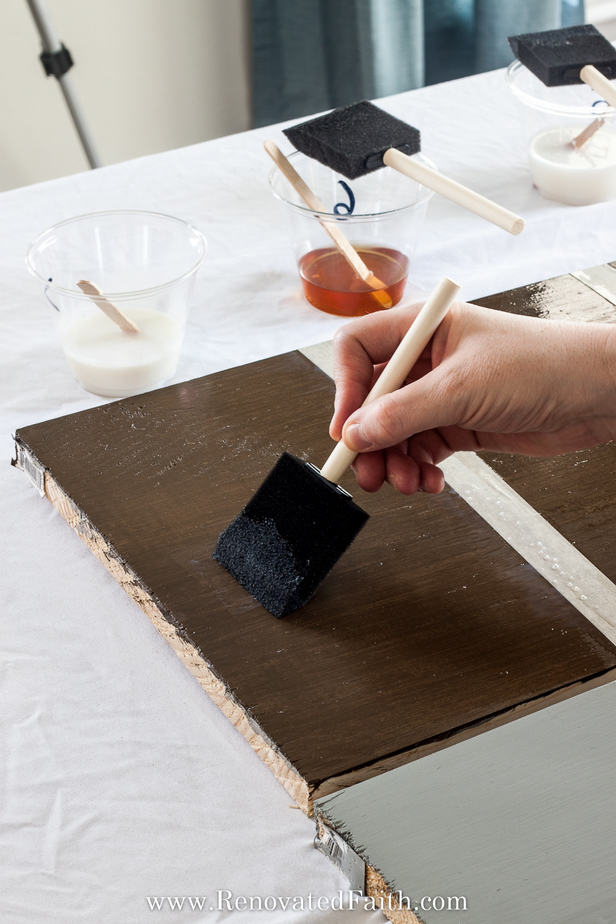
My Best Tip: How to Protect Painted Furniture and Stained Pieces-
To give painted furniture maximum protection, top coat paint with 3 coats of clear coat. This will give your piece maximum hardness and durability. This sounds excessive but our top three clear coats all have very fast dry times, which will cut down on the time to finish your project. Sand very lightly in between and follow the dry time recommended on the can.
Best Protective Finish for Stained Wood
For the best protective finish for stained wood, I’d pick General Finishes High-Performance Top Coat. This General Finishes Top Coat provides maximum durability and is very waterproof. One reviewer complained about slight yellowing on a white piece of furniture but that’s actually a plus for stained furniture as it warms up the tone slightly making it the best clear coat for wood. After sanding lightly, all three top clear coats would be a great choice for stained furniture.
How to Clear Coat Stained Furniture
Just like clear coating painted furniture, be sure to let the stain dry for at least 48 hours and sand very lightly. For stained finishes, I recommend “sanding” with a paper bag so you don’t mar or scratch the stained finish. The paper bag is enough to rough up the surface so the clear coat sticks to the stain but it doesn’t leave any scratches in the stain.
To provide a thick clear coat for wood, add three thin layers of clear coat for maximum durability. Use an inexpensive foam brush (like this) and brush in one direction for each coat. Allow each coat to dry according to the instructions on the can.
How The Other Contenders Performed:
Polycrylic Top Coat: How to Apply Polycrylic without Streaks
Minwax’s Water-based Polycrylic Top Coat is a commonly used clear coat for furniture refinishing. All seven topcoats are good products but I found our top three clear coats all performed with better results than Polycrylic in terms of durability and water permeability.
The biggest downside to polycrylic was the pretty obvious water ring left on the sample but it provided a very smooth finish.
Several furniture painters have trouble with polycrylic streaking or forming stripes on the surface. I’ve seen this problem as well but what helps is to add a little extra product per coat on your surface. By adding extra polyacrylic, it seemed to minimize streaking significantly!
Oil-Based Polyurethanes: Minwax’s Oil-Based Polyurethane and Varathane’s Oil-Based Polyurethane
Oil-based polyurethanes are great when it comes to having a waterproof surface as they both left no glass rings on the surface of each sample. HOWEVER, there were several bubbles in the Minwax surface and both caused pretty severe ambering of the painted surface.
The Minwax polyurethane separated so it took me a while to stir the product so it was once again consistent. If you don’t stir in the solids, your finish will be a high gloss finish.
So, while they could both be used for stained surfaces, they would not be a good choice for painted furniture, especially light or white paint colors. If you want to use an oil-based polyurethane, Varathane’s had the best results by far – click here for the current price.
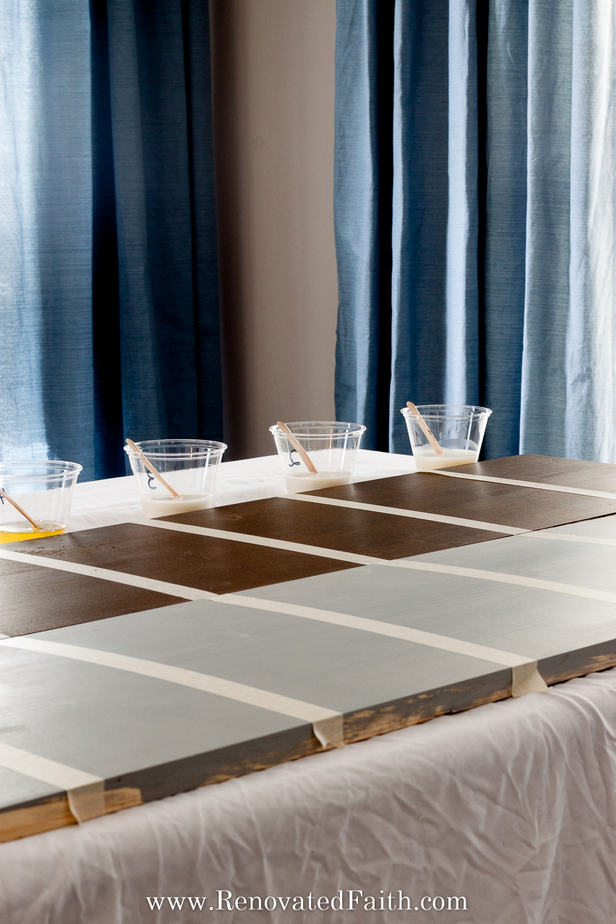
What Sheen Should I Use on Furniture?
Sheen refers to the amount of shine on a piece of furniture ranging from high gloss, gloss, semigloss, satin, and then matte for the least shine. Matte is the most popular now as you will see it often on farmhouse style or chalk-painted furniture.
The shinier the piece the more durable and easy the surface is to wipe off. So, if you need a more durable finish, satin is often a good option because it’s not very shiny so you still have the chalk paint finish, but is a hard, waterproof surface.
The more gloss a surface has the more it will show imperfections in the surface so a matte sheen is much more forgiving than a semi-gloss. The clear coats I experimented with were all matte and satin finishes.
☑️ My All-Time Best Furniture Painting Tips & Tricks (FREE PRINTABLE)
Don’t forget to download the FREE step-by-step printable checklist that shows you the entire process I’ve used on dozens of furniture pieces while saving you time and money!
FAQ’s – Best Clear Coat For Painted Wood:
Can I Paint Over Polyurethane without Sanding?
Someone asked me how to refinish a piece of furniture that had been clear coated with an oil-based polyurethane. I would not attempt to refinish this surface without at least sanding and adding a primer and I describe it in this post here: How to Paint Furniture the Easy Way. Remember, you are not sanding to remove the surface you are just barely roughing up the surface to accept primer or paint (How to Stand Furniture in 5 Minutes).
Can You Put Polyurethane Over Wax?
A good rule of thumb is that nothing will stick to wax except primer. So, don’t put any clear coat over wax including polyurethane. You can however wax over polyurethane if you like the buffed look of wax but a much easier option is using our pick for the best chalk paint topcoat.
Do you Have to Seal Chalk Paint?
If your chalk-painted piece will not come into contact with any spills, or drinking glasses and you aren’t worried about the finish rubbing off on your hands, you don’t have to seal it. But most of the time, you’ll want to be able to set a drink on a piece of furniture. Also, you don’t want to worry about the color rubbing off on clothing. Therefore, it’s a good idea to seal all chalk-painted furniture.
What is the Best Clear Coat for Kitchen Cabinets?
If you are wondering how to seal chalk-painted kitchen cabinets, your best bet is Varathane Water-Based Polyurethane. Although it’s water-based, it is the most durable top coat that I have come across that won’t yellow. I have applied it on 5 high-use pieces of painted furniture and they all look as good as the first day I applied the clear coat.
I wouldn’t recommend painting kitchen cabinets with chalk paint as I discuss in my post: A Better Alternative to Chalk Paint. If you are wondering what clear coat to put on latex-painted cabinets, I would consider going without one. If you use a good paint made for cabinets, it should be durable and water-resistant enough without the trouble of a topcoat. However, if you have chalk-painted cabinets, you will need some sort of protective finish to make them durable enough for high-traffic areas.
IMPORTANT TIP: If you are thinking about using chalk paint on kitchen cabinets, best sure to check out this post: The Ultimate Guide to Painting Cabinets Like A Pro
Should I Use a Spray Clear Coat for Wood?
Spray clear coats seem like they are incredibly convenient and if you are working on a craft project, they are. Although they are a popular option for furniture, spray clear coats are generally a bad idea as they are notorious for leaving stripes on your furniture piece. Trust me; opt for the brush-on topcoats to get a uniform look! (If you are already painting a picture frame or small project with spray paint, then spray topcoats are a great option).
UPDATE: Since writing this post, Varathane has come out with a water-based wood paint sealer spray. I haven’t used it personally but the reviews are actually pretty great. Also, you can use it as a chal paint sealer spray. See the reviews and the current price here: Varathane Water-Based Spray Clear Coat for Wood
After Staining Wood, Do You Have to Seal It?
A stain is a product that penetrates wood pores instead of covering them. Therefore, the surface can still be easily scratched as there is no protective finish for a typical stain. For that reason, it is best to seal all stained wood to prevent scratches from ruining the finish. Gel stains are thicker and more protective so you can get away without a clear coat for lightly used pieces. Just lightly sand with a paper bag before sealing with a clear coat.
What Kind of Paints Can Be Clear Coated?
Clear coats can work on several paint options including mineral paints, media paints, decorative paints, chalk paint and latex. When sealing chalk paint with one of the sealer products, in this post, you don’t have to invest in a wax brush.
How Long Should Chalk Paint Dry Before Sealing?
Be sure to wait between 24-72 hours before applying a sealant to chalk-painted furniture pieces. Giving the surface a longer dry time will ensure even better results for the final finish. Be sure to always check the instructions from the chalk paint manufacturer.
What is the Best Acrylic Paint Sealer for Wood?
In my post on How To Stencil on Wood Without Bleeding, I used the Varathane Water-Based Polyurethane and had excellent results! I love that it seals acrylic paint just as well as it seals chalk paint or latex.
What is the best paint sealer for wood crafts?
On most wood items, you can use a decoupage medium like mod podge on wood crafts or home decor items like coasters or wooden trays. But I prefer using a wood sealant like Varathane Waterbased Polyurethane because it goes on smoother, never yellows like a polyacrylic varnish and is much more durable. It also never leaves watermarks. Mod podge will degrade over time if it is in contact with water on a regular basis. Always use a true wood sealer on wood materials like beadboard wood panels, or wooden paneling on furniture or wainscoting.
Want To See More Furniture Makeovers?
To see my best furniture reveals click here: 15 Stunning Painted Furniture (Before and After Reveals)
Posts Related to the Best Top Coat for Paint:
The Ultimate Guide to The Best Furniture Paint
Milk Paint vs. Chalk Paint vs. Latex
Best Tips for Painting Furniture
A Better Alternative to Chalk Paint for Furniture (Get the Aged Look of Dark Wax Easily)
How to Paint Furniture Legs Quickly & Easily
The Best Way to Stencil (Without Paint Bleed!)
Faux Stain with Latex Paint (7 Different Color Options)
The Absolute Best Paint for Cabinets – 24 Brands Blind-Tested & Reviewed
General Finishes Milk Paint Review
Faux Driftwood Finish for a Weathered Wood Look
How to Make IKEA Furniture Look Expensive with Paint
How to Turn Acrylic Paint into Fabric Paint
How to Sand Furniture in Less Than 5 Minutes
How to Fix Damaged Wood: Caulk, Wood Filler, or Epoxy?
Applying the Right Top Coat to Wood Furniture: Final Thoughts
Refinishing furniture can be a great way to get the look you want without paying a lot. It is also so rewarding if you know the right way to seal and protect your finish. There are several different ways to seal a piece of wood furniture and several products in the marketplace. Hopefully, this blog post will help you find the right product for your Project. In terms of smoothness, clarity, durability, and protection from water, I’ve reviewed our best picks above. You can now finish your next project with confidence knowing it will be protected and look gorgeous for a long time with the absolute best paint sealer for wood.
Good luck with your furniture painting project and I’d love to answer any questions you have in the comment section below.
Blessings,

Be sure to follow the fun here!
Email Subscription | Instagram | Pinterest | Facebook | Twitter
Reviews for the Best Clear Coat for Wood (Best Sealer for Chalk Paint)
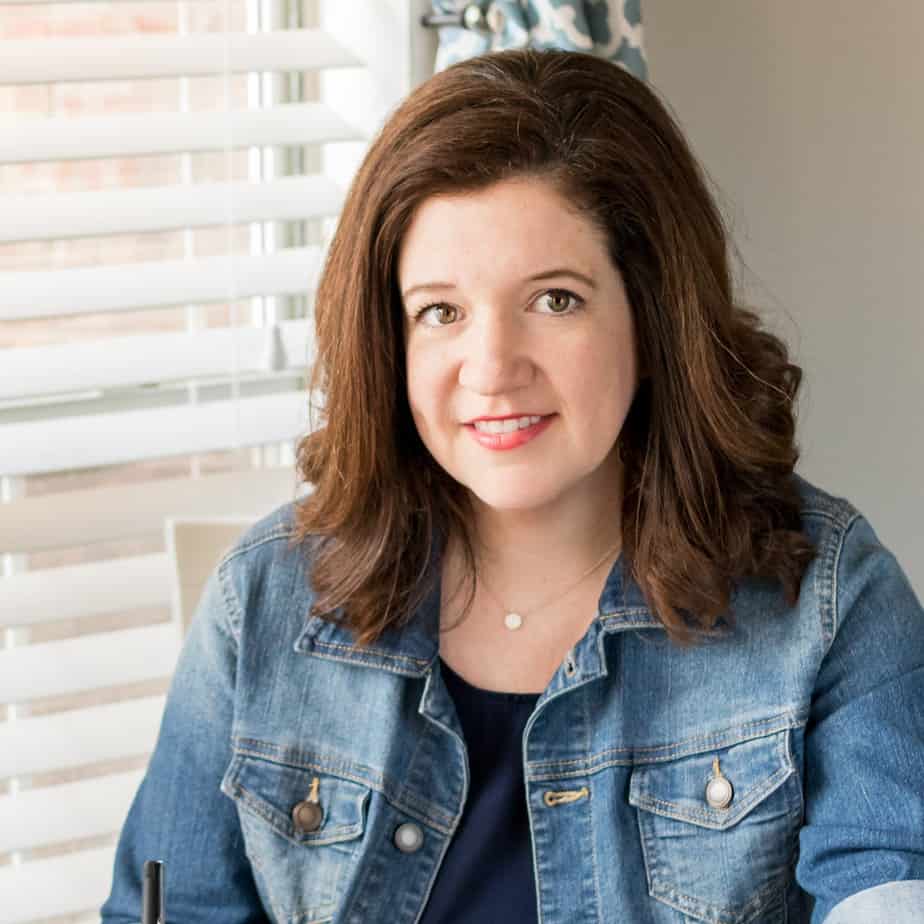
Karin Peters is a DIY expert and the creator of Renovated Faith. She is a furniture painter, a home design consultant, and a tenacious problem solver determined to help you transform your house into a home. With 17 years of experience with DIY home improvement, she researches and analyses professional processes to adapt them to be easy and cost-effective for DIYers. She then tests every project and product before it appears on the site in a detailed, step-by-step format. After attending Texas A&M University, she received her Master of Divinity with Biblical Languages at Southwestern Baptist Theology Seminary. Her passions unite in Renovated Faith, which shows readers how to create a home that serves them so they can pursue their God-given purposes. About Renovated Faith | Editorial Policy | Facebook | Twitter | LinkedIn

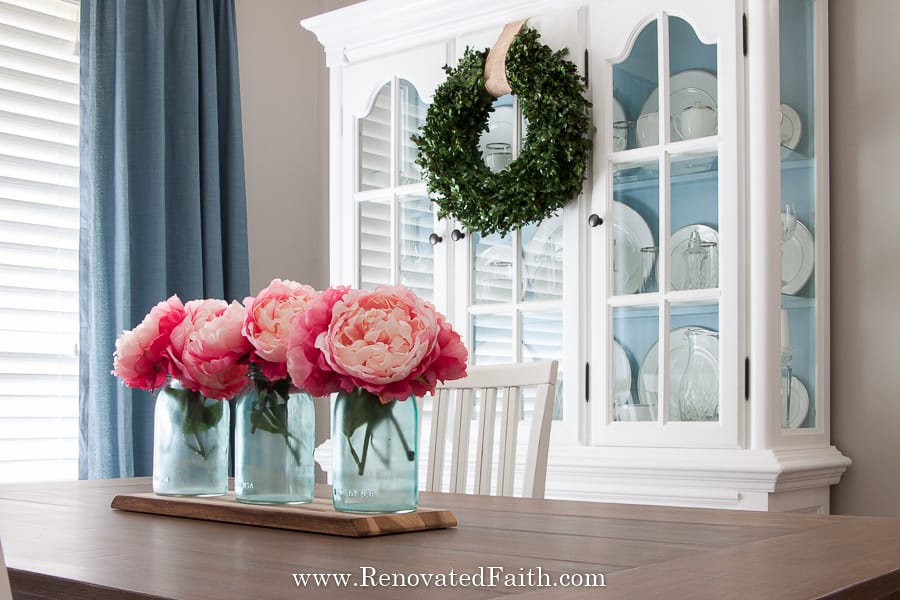
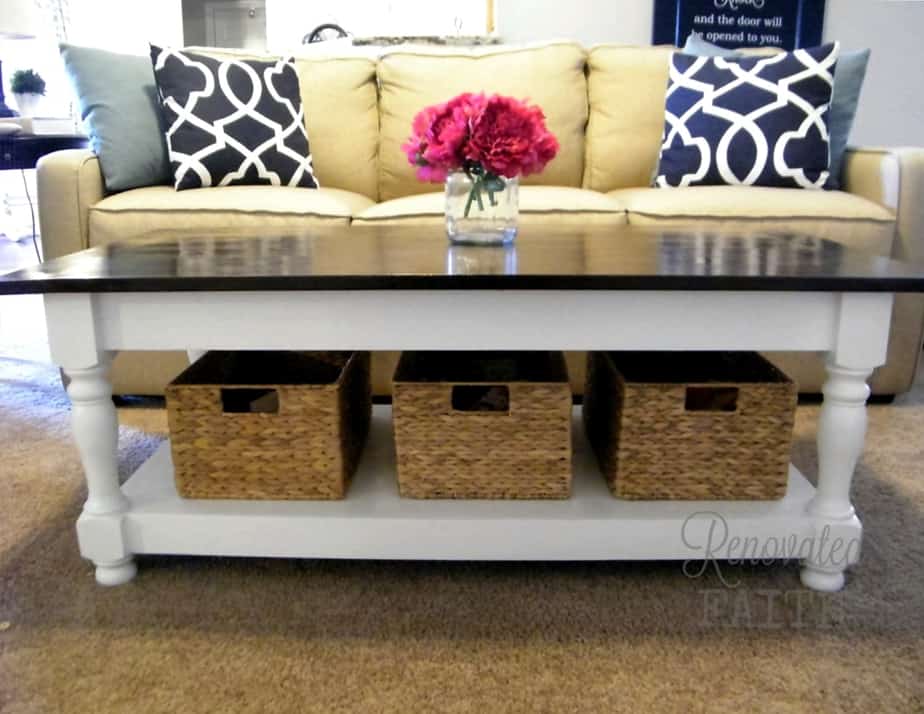
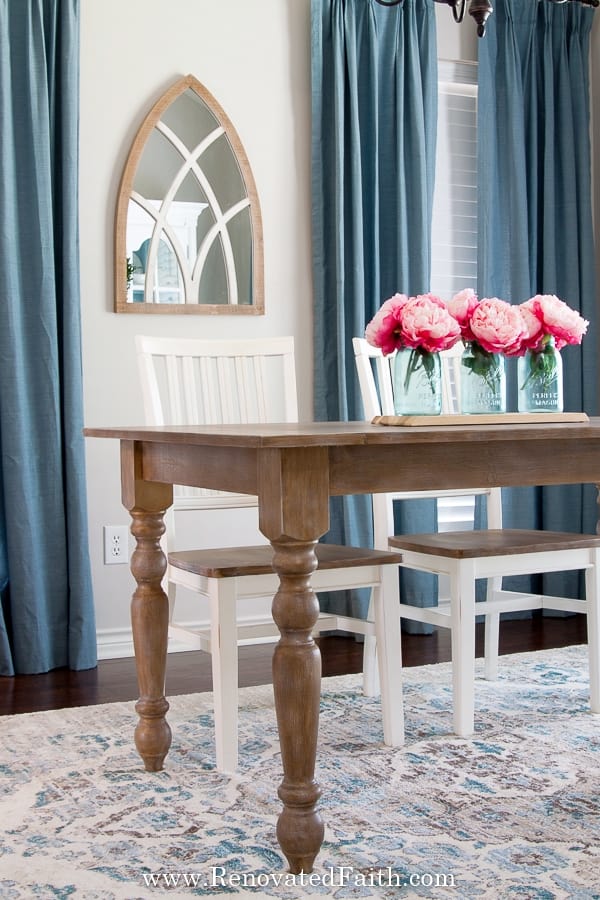

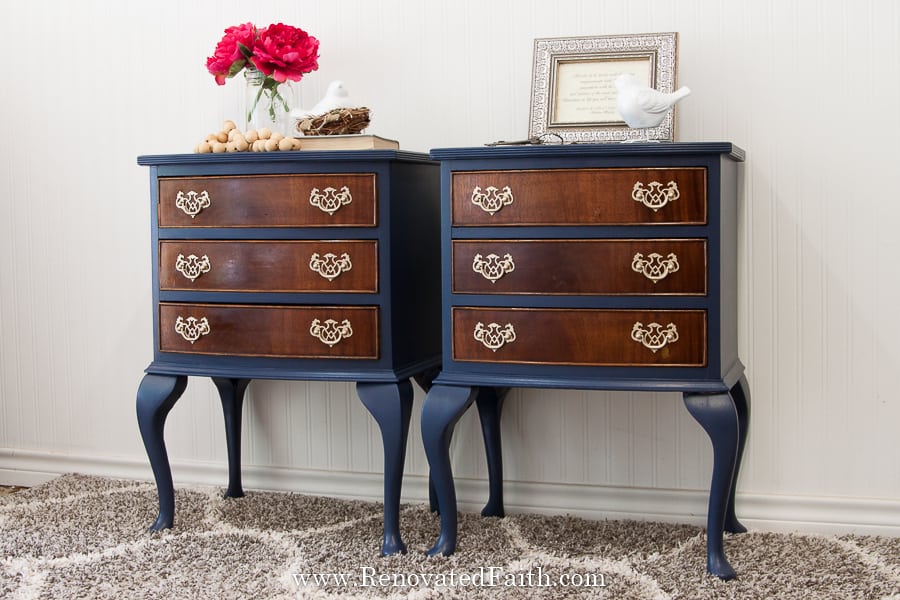

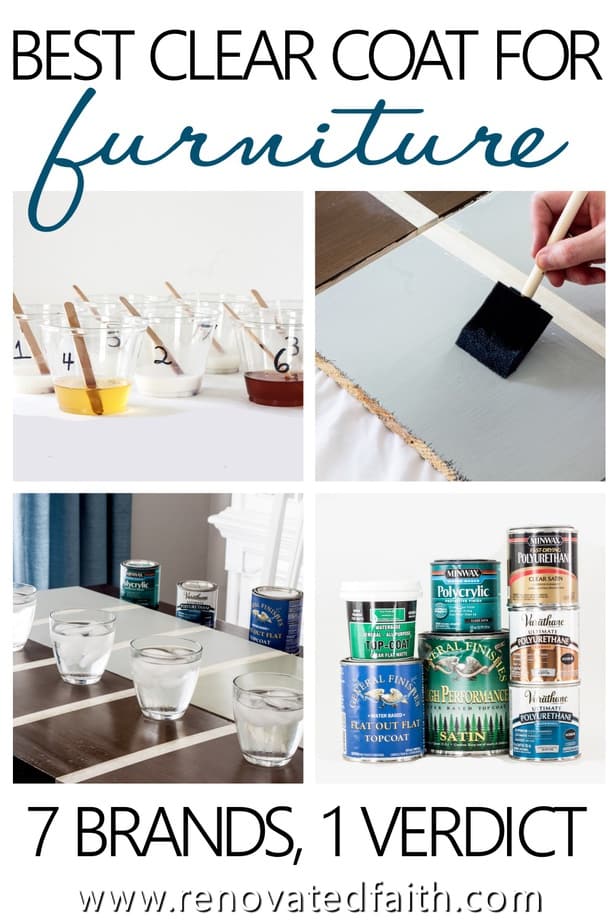
Hi Karin. After reading this post regarding the best top coat, I decided I want to give General Finish Flat out Flat a try over my chalk painted armoire. When I was about to order I noticed there’s two different versions of General Finish top coats. There’s the water base Top Coat High Performance in flat, this one actually has different textures, flat, gloss, satin, or semi gloss. The other is Flat out Flat. They are both from General Finishes. Are they both basically the same? This is my first project so I just want to be sure. I’m so glad I came along this post, so helpful! Thank you!
Hey Reeny,
It’s so funny that you are asking this because I was wondering the same thing. General Finishes came out with the High Performance top coat in matte after this post was written. I probably need to test it too! I’m willing to be that it’s a really good product. But also, Varathane has come out with a matte topcoat. And since I had the best results with that one in satin, I would lean toward trying their matte version: https://rstyle.me/+3bFRM_2AVu6CfoiaiBjRjg Let me know if you have any other questions – Karin
I will be putting a top coat over my chalk painted armoire. I plan on getting the General Finishes product after reading this post. I looked it up and I see there’s two different varieties, I’m a little confused on which to get. There’s the General Finishes Water base Top Coat High Performance in Flat, than there’s General Finishes Flat Out Flat, they are both water based Top coats, is there a difference between the both?
Great question Laureen! After writing this, General Finishes came out with a High Performance Topcoat in Matte and not just satin. So, I would probably lean towards that product. But also, I realized the Varathane Waterbased Polyurethane that came in first has a matte version now, so I think I would opt for that one but all three should be good products. Here’s where you can find the Varathane WB in matte: https://rstyle.me/+3bFRM_2AVu6CfoiaiBjRjg Let me know if you have any other questions. Thanks Laureen!
Hi Karen, I actually forgot to ask… how long after I chalk paint my armoire do I need to wait before I can apply a top coat? I’m hearing different answers, some say I can apply 24 hrs after painting, than I saw where you have to let the chalk paint cure for 2 to 3 weeks before applying topcoat. What do you think? Thanks so much!
I’d wait 24 hours to be safe. It doesn’t have to cure to apply the topcoat. Let me know if you have any more questions Laureen! – Karin
Hi Karin!
Thank you for all your wonderful information! I’m new to repurposing furniture and you have helped me tremendously.
I do have a question though. I’m using SW emerald paint for my project. (For some reason the man told me I couldn’t get the pro classic in the color I wanted). Anyway, I’m approaching the point of applying the top coat and need to sand, but the emerald paint has a shine to it. When I lightly sand using 400 grit sandpaper I’m noticing that the shine is being removed and leaving dulled streak marks (I’m assuming it’s from where I’m pressing down harder than in other areas). My question is, will these streak marks show up after I apply the poly or should I sand my paint job to the point of it all looking a bit dull?
I’ve searched the Internet for answers, but can’t seem to find anything about what sanding your paint job looks like before applying a top coat.
Thank you for sharing your wisdom 🙂
Blessings.
Hey Melanie, That’s a great question. When you apply the clear coat, it will give everything the same sheen (depending on the sheen of your clear coat). Apply one coat and apply at least one more coat after the first dries. I don’t usually sand between coats of the clear coat. Please let me know if you have any other questions!
I just painted shelves white Marquee Paint. Since they are white which top coat so they don’t yellow if you can plz help. Never painted
If you used Marquee, I think you can get away without a clear coat unless they will be used very heavily. My favorite clear coat that does not yellow is Varathane’s Water-based Polyurethane!
I’ve bought a piece of furniture from Nadeau: Furniture With a Soul and I’m going to paint/stain/top coat it to look similar to Ethan Allen’s large Ming media cabinet in the peacock blue. I think it’s painted with wax over it. I am planning to do latex with a watered down darker shade of the same color, and then a tinted glaze, then a top coat. I saw the information about the General Finishes top coat. I hope I’m headed in the right direction. I’m planning to use MinWax gel stain or another gel stain like Java gel or General Finishes on the inside as it’s more of a stained look and different from the outside.
I wanted to ask if this sounds right. I also want to check on your mention of using wax and polyurethane together. My understanding is that polyurethane on top of wax or vice versa is highly flammable. Maybe it’s just the rub-on poly I used for my kitchen area dining table but I thought it was a general statement. What are you aware of in that respect. The piece I’m doing is 86″ long and 31″ high, under an arched window that is about 9′ wide and 12′ tall starting about 33 inches from the floor and next to a fireplace, so I have to make sure I don’t do something that increases the risk of the piece catching on fire.
I’ll look forward to your reply to my questions.
Hey Mandy – I don’t think I’d use wax and poly together. I don’t usually use wax at all but use the clear coats mentioned in the post. Let me know if you have any other questions and I’d love to see pics when you are done! Thank you!
Your clear coat testing save me from buying 2 new end tables! My end tables were in good shape except for the tops. I was shopping for new ones when I saw you painting tips. I was nervous to try redoing the tops but your instructions were clear and seemed pretty simple. The finish on the tops was chipped and cracked so I sanded and restrained them then added the clear coat to protect them from being ruined by liquids again. They turned out perfect and so durable!!
This makes my day Jeannie! Thank you so much for letting me know. I’m glad the post came in handy. Have a great day!
I must say, I have loved Polycrylic since it first came out for its quick dry time as well as durability. A few years ago, I refinished our coffee table creating a driftwood finish on the top with white chalk paint legs. I brushed on 4 coats of polycrylic on the top and 2 coats on the legs. My husband is disabled and unable to inject himself with insulin each night, so I do it for him. I prepared the cotton ball with alcohol before knocking the bottle of ubbing alcohol all over my beautiful driftwood table. To my surprise, there was no damage whatsoever. I love Polycrylic.
Hi there! Loving your article! I refinished our handmade kitchen table and now it’s time to seal it, and the last thing I want to do is ruin all the hard work I’ve put into it! The table top is a dark espresso stain while the legs are painted white. I’m looking for a stain to hopefully use on both parts of the table or to easily get two different cans at somewhere local like Home Depot. Would you recommend the Varathane Water-based Poly on the table top and legs? Just don’t want the white legs to yellow! Thank you!
Hey Hallie, Waterbased polys don’t yellow so you can use the Varathane waterbased on the top and legs!
Karin, I love your in depth articles and the comparisons you have done on different paints & finishes.
I was wondering if you have painted furniture for outdoors, of course using exterior durable paint, and if you have any recommendations for clear, protective finishes for these pieces?
I live in Alberta, Canada, where we deal with huge temperature swings. I love repurposing furniture, and would like to put some pieces outdoors in semi protected areas, but would like them to be durable to both moisture & heat/cold.
Any thoughts would be so appreciated. Thank you.
So helpful, thank you! I bleached my wood dining table- any suggestions for a clear topcoat that won’t darken the finish? I went to put water based poly on and was surprised the “wet” looked remained after drying. Bummer.
Hmm, good question. How long did you let it dry? I think all of them might darken it slightly.
I have no idea how old this post is if you will respond… but I read a lot of your blog about why you Don’t like chalk paint compared to your method but have you actually ever used chalk paint? And what was the brand that your friend used on her cabinets?
Hi this is a pretty recent post and I’ve used Annie Sloan Chalk Paint.
I’m looking for advice: I sanded down my kitchen table, stained it, and then put three coats of Minwax Polycrylic on it. In the first few weeks of use we started noticing permanent scratches. Then I put three coats of Varathane Water based Polyurethane on it, gave it time to rest, and resumed using it. We now mysteriously have a white ring on it , and if we leave water on it for 20 plus minutes blue marks appear and then fade over time. My question is (since I used your number one recommendation) do you think I just have too many coats on it, making it susceptible to rings? Besides that it looks and feels great but I’m afraid it will continue to get marks.
I’m not a huge fan of polycrylic because it is known for leaving streaks so I have to wonder if the layers of polycrylic are making moisture come to the surface when a cold drink is placed on it. You can give it a few weeks to make sure it is cured all the way but if it keeps leaving marks, I would sand it down again and use just the Varathane Water-based Poly. I have over 6 coats of this on our coffee table and haven’t had any problems with drinks. So sorry you are having to deal with this and let me know if I can answer any other questions.
This post is genius and so helpful! Thanks for your comparison of all the topcoats. Used General Finishes flat out topcoat today, and it was a dream to apply and looks awesome.
Thank you so much Liz! Glad you had a good experience with it. I love General Finishes topcoats!
Thank you for all the information. I have been wanting to know how to create furniture with a chalkboard for my son’s home classroom. You have provided the solution.
So glad to here that Tomika! Thanks for stopping by.
I am so THANKFUL for your post. I am inexperienced and in the process of finishing antique Duncan Phyfe table and chairs. I was so confused after reading so many posts and then found yours!!!! I just want to THANK YOU for going to all the work of testing the finishes to come up with the best one. That is what it takes but I couldn’t do that.
I can not tell you how much I appreciate you. It helped me so so much.
You are so sweet Marilyn! I’m so happy that it was helpful! Have fun finishing your table!
HI Karin! Thanks for all of the wonderful information in this blog! I’m planning to repaint an antique dresser for use as a changing table in our nursery. I would like to only use a clear coat on the top if I can (pure laziness), but I’m worried that it will change color over time and look different from the rest of the piece. I’m going to be painting it a dark green and was thinking of using the Varathane you recommended. What do you think?
Hey Alyssa,
Great idea on the clear coat. Since you are using the water-based varathane it will not discolor over time like some oil-based. Thank you for your sweet comment and I wish you all the best!
Karin
Thank you for sharing the wealth of amazing information! Appreciate all your effort! Blessings to you as well, Karin.
Hi Karin, I just had to comment because I am shocked at your top pick!! I needed a sealer for our homeschool table which came from the store with a very very matte, chalkboard-like finish that was almost like running your hand across extrafine sandpaper. So I haunted woodworker’s forums online and determined that the Varathane Ultimate Water based crystal clear interior satin stuff – yup, exactly the same can as your top pick, I double checked – would be the best thing to use. Well stirred and two lovely smooth coats later, and a week to cure, and… it has not held up AT All. It scratches so incredibly easily! I have even had plastic container bottoms scratch it. It’s totally trashed after one year of use. I’ve switched to General Finishes high performance flat for one or two projects since and though I haven’t had the chance to do a tabletop I’ve been very satisfied with that one. Your test makes me wonder if something about the table surface I used the Varathane on didn’t allow for good adhesion. I’m scared to ruin another project with it, but I could totally try my own side by side trial over paint and wood samples and see how that turns out. So weird!
That’s so strange Julie! I’m so sorry to hear that. I’ve never had that problem with the Varathane Waterbased Top Coat. You might test it on a piece of wood before using it on your next piece. I’m wondering if it had to do with the finish of the table.
Me and my spouse have a small business fixing and selling vintage furniture, and though we don’t do a lot of chalk or latex work (because we usually work with natural wood grain) we have had a little experience with water based clear coats, and in our experience they are much less robust than oil based finishes. You need more coats of water based product, and they require a longer time then usually advised to cure. We eventually realized that it can take up a month for water based paints and clear coats to fully cure, and if you apply too many coats or any wax before cured, you risk that it won’t dry properly.
I can see that being a problem with polycrylic but the Varathane water-based poly has been great. I put 6 coats on a table at 30 minute intervals and have no problems with drying, curing or durability. Thank you Stefen!
Hi! I am a noob painter and I found your article very useful – thank you!
About a year or so ago, I picked up a paint at Lowe’s that was supposedly a two-in-one and the paint guy told me I wouldn’t have to prime or seal with it. I painted a wooden sewing cabinet with it and now I have decided to go back and add a sealant. I painted the piece with a cabinet roller and the whole thing just feels sort of bumpy or pebbley if that makes any sense. I’m hoping a sealant will help protect it and maybe give it a more smooth finish.
Based on your research here, I’m thinking I should go with the Varathane, but I’m really confused on the application. Do I need to rough up my paint job with sandpaper before I apply it first? I feel like it would just destroy it, ha! I tried that on a small little thing I did once and it ruined the paint. This particular piece is a very light color, so I definitely want to avoid anything that yellows.
I would appreciate any wisdom you could share with me because I am so afraid I am missing something and am going to screw it up!
Thank you,
Dee
Hey Dee, These are all great questions. Since the finish is kind of pebbly, you are probably right, it might “distress” it if you aren’t careful and I know that’s not the look you are going for. I feel confident you can use the Varathane (make sure to get water-based) clear coat over the surface without sanding. You could always paint on a small area in an inconspicuous spot, let it dry and see if it tries peeling off. Let me know if you have any other questions!
Thank you so much for your response! Sanding is what scared me from doing it to begin with. I’m so unclear on when you are supposed to sand and when you aren’t.
I will purchase the water-based Varathane and see how it goes!
Karin, I am a first-time reader of your blog and I must say that you packed a powerful punch with this one! Your research project was so cool! I am impressed with your method and results. Thank you for going to such a time consuming comparison of these top coats. You can add me to your list of followers!! Have a wonderful Mother’s Day.
Thank you so much for that Cecilia and Happy Mother’s Day to you!! I have always wondered myself which top coat was the absolute best and figured it was worth a post on the topic. Thank you for stopping by! I appreciate it!